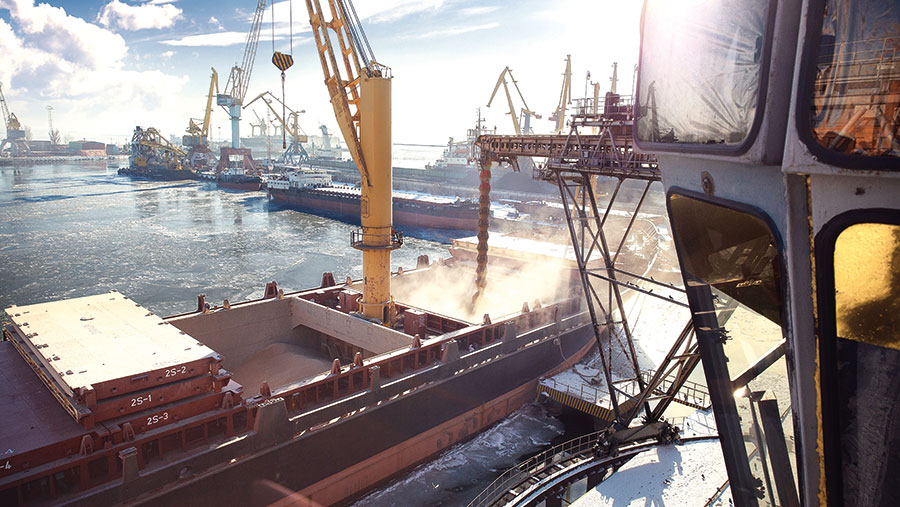Input and output costs hit new highs as Ukraine crisis deepens
 Toxicoz/Adobe Stock
Toxicoz/Adobe Stock Agricultural budgets for the year ahead have been thrown into turmoil, with both input and output costs driven higher by the tragic events unfolding in Ukraine.
Grain prices have surged again this week, as the full impact of the Russian invasion sinks in, with London May 2022 wheat futures hitting a record £285/t mid-morning on Wednesday (2 March), before closing the day at £265/t.
That compares with the £220/t it was worth in mid-February.
See also: How Ukraine war will impact its farming – agronomist’s view
Meanwhile, ex-farm spot values collected by Farmers Weekly on Wednesday put feed wheat at £266.75/t – up more than £40/t on the previous week.
‘Extremely bullish’
With Russia and Ukraine accounting for 25-30% of global wheat exports, AHDB analysts have described the disruption to supplies as “extremely bullish”, as key buyers from the region – Egypt, Indonesia and Turkey, in particular – have had to seek other origins.
“The conflict prevents exports from Ukraine in the short term as ports are currently closed to commercial shipping,” they said.
Major international companies, including ADM and Bunge, are understood to have suspended operations, and grain loading stopped soon after the invasion.
“Russian exports also face severe disruption, with international sanctions limiting credit availability and disruption to shipping routes,” AHDB explained.
Globally, wheat stocks are already dangerously low, and news that the 19m tonnes of wheat and 17m tonnes of maize that were due to be shipped from Russia and Ukraine before the end of the current season cannot now be traded is adding to the upward pressure.
Longer term, the outlook remains “highly uncertain”, says AHDB. While the majority of wheat in Ukraine is winter-sown, maize and oilseeds are spring crops and questions remain about the ability of Ukrainian farmers to complete field work.
Doubts also remain about harvest prospects, both in terms of yield, collecting the crop and marketing it.
Inputs
But while output values have soared, so too have input costs, squeezing any potential margin gains for UK arable and livestock farmers.
Russia is a key exporter of ammonium nitrate and urea, while Ukraine is a major supplier of ammonia, says Calum Findlay of ADM Agriculture. Russian gas is also fundamental to EU fertiliser production.
Domestic UK production remains in some doubt too, as natural gas prices have soared, topping 400p/therm on Wednesday – almost 40% higher than the late September 2021 values that led to the temporary closure of production at CF Fertilisers’ two UK facilities.
“UK stock levels of nitrogenous fertilisers are low and the likelihood of fresh vessels arriving is small,” said Mr Findlay. Prices have firmed accordingly.
Meanwhile, fuel prices are climbing rapidly. Brent crude topped $110/barrel for first time in eight years on Tuesday (1 March), with an immediate knock-on effect on red diesel prices.
Hull-based supplier Rix says delivered values have been climbing by 3-5p/litre a day since the Ukraine crisis began, with a 1,000-litre farm delivery quoted at 92p/litre on Wednesday – a 15% rise on the week and almost double where it was a year ago.
Impact for livestock and dairy farmers
For livestock farmers, including pig and poultry producers, the most immediate impact is going to be on feed costs.
“Rapeseed meal, for example, is up by £50/t since 23 February, currently quoted at £369/t ex-Erith,” said Simon de Jongh of Straights Direct.
“Soya is not so bad as it mostly comes from South America, but sunflower meal is more directly affected, coming from Ukraine.
“Everything is getting firmer, including haulage rates, which will all have a direct and immediate impact on livestock farmers.”
Dairy farmers will also be hit by rising energy costs. A report from Kite Consulting suggests the loss of Ukraine and Belarus from global dairy markets will lead to higher dairy prices, with international traders having not yet fully factored in the Russian invasion.
“But a sharp rise in global energy prices will mean dairy farm margins being hit directly, through rising on-farm energy and fertiliser costs,” says the report.
This will limit any expansion of milk supply in the short term, especially as UK supermarkets will be reluctant to pass on supply chain cost increases to end consumers.
